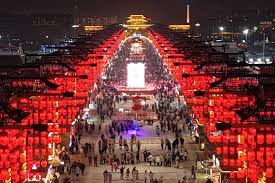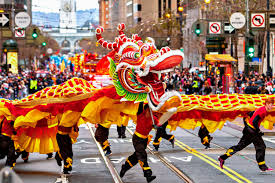Chinese people embrace tourism to celebrate Lunar New Year

Beijing: Traditionally, Chinese people stay at home with their families for the Spring Festival, also known as Chinese New Year, the most important festival of the Chinese calendar.
But many families are now opting to travel during the holiday, attracted by cultural activities such as lantern shows, flower markets and temple fairs on offer around the country, or traveling overseas to discover more of the world.
At Beihai Park in Beijing, calligraphers can be seen writing the Chinese character “Fu” on red, square paper and handing the decorations out to tourists. The red posters are stuck onto doors or windows to celebrate the Spring Festival, as the character symbolizes a blessing or happiness.
“I felt very lucky to receive a ‘Fu’ poster as a gift, and I will take home the blessing it carries,” said a tourist surnamed Xu from south China’s Guangdong Province.

Public parks in Beijing received over 250,000 tourists on Feb. 10, the first day of the Year of the Dragon, surging 153.78 percent from the Spring Festival last year and 56.41 percent from 2019, according to local authorities.
Shanghai has launched more than 200 cultural activities during the eight-day Spring Festival holiday starting from Feb. 10, including art exhibitions, plays and food fairs, creating a festive atmosphere in the city for both locals and tourists.
About 1.73 million tourists visited Shanghai on Chinese New Year’s Day, up 4.58 percent year on year, data released by the Shanghai Municipal Administration of Culture and Tourism showed.
According to tourism platform statistics, domestic travel orders soared 102 percent year on year on the eve and first day of the holiday, significantly exceeding the level seen over the same two days in 2019. Beijing, Shanghai, Xi’an, Kunming and Harbin are among the most popular destinations this year.
To welcome the Year of the Dragon, 20 lantern shows featuring elements of the Chinese dragon are being staged at the ancient city walls in Shaanxi’s Xi’an, the largest and best-preserved ancient city walls in the country.

“Although it’s quite crowded and cold at night, it’s worth coming!” said a visitor surnamed Zhou from Beijing. He said that his 12-year-old daughter has recently become a big fan of traditional Chinese clothing and had been looking forward to her trip to the ancient capital.
“Happy Chinese New Year from abroad! I had a great time roaming around Singapore!” a tourist from Chongqing surnamed Zhang posted on her social media on Chinese New Year’s Eve. In her photos, she and her daughter are in summer clothing and her parents can be seen taking pictures in front of greenery.
Although the trip was an impulsive decision, it was only made possible by a recent visa-free travel policy and the fact that a direct flight from Chongqing to Singapore takes just five hours.
More Chinese people like Zhang chose to ring in this new lunar year in a foreign country. China’s National Immigration Administration has estimated that the Chinese mainland will see a daily average of 1.8 million inbound and outbound passenger trips during the Spring Festival holiday this year, approximately 3.3 times larger than last year’s figure.
Cheng Chaogong, chief researcher at the Tongcheng Research Institute, which is affiliated with a major online travel agency, said that countries such as Singapore and Thailand are becoming travel hot spots after their implementation of visa-free travel policies for Chinese tourists. These overseas trips are expected to give a strong impetus to tourism spending, Cheng said.





